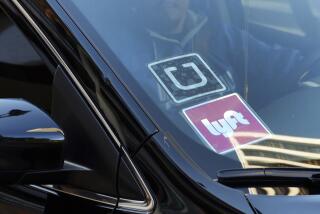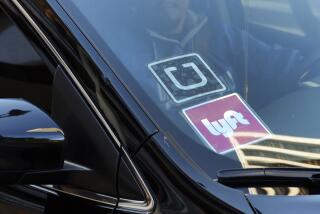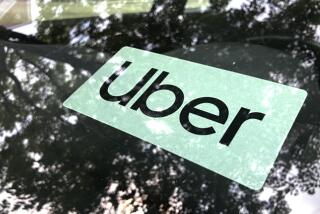Uber’s past is still haunting its business

Not long ago, Uber Technologies Inc.’s fast-charging, take-no-prisoners approach to growth and regulation was seen as one of its strengths. But as the ride-hailing company prepares for its much-anticipated initial public offering, the consequences of that reputation continue to cast a long shadow over the company.
The San Francisco company has been trying to rehabilitate its image after a cascade of scandals in 2017 turned customers away. The turmoil resulted in the ouster of founder and then-Chief Executive Travis Kalanick and the acknowledgment that Uber had developed a culture of harassment.
For the record:
6:35 p.m. April 11, 2019An earlier version of this article said Uber lost about $1 billion in 2018. The correct figure is about $3 billion.
Dara Khosrowshahi, the current CEO, has tried to reframe Uber as an apologetic company cognizant of its past mistakes. But in regulatory filings Thursday disclosing to investors Uber’s finances, Khosrowshahi acknowledged his company has a long way to go.
“Some of the attributes that made Uber a wildly successful start-up — a fierce sense of entrepreneurialism, our willingness to take risks that others might not, and that famous Uber hustle — led to missteps along the way,” Khosrowshahi wrote.
Among the many risks the company laid out in detail, Uber lists its workplace culture and says that recent changes “may not be successful, and regulators may continue to perceive us negatively, which would adversely impact our business, financial condition, operating results, and prospects.”
“Our workplace culture and forward-leaning approach created significant operational and cultural challenges that have in the past harmed, and may in the future continue to harm, our business results and financial condition,” the filing says. “Our focus on aggressive growth and intense competition, and our prior failure to prioritize compliance, has led to increased regulatory scrutiny.”
Uber’s filing repeatedly notes the resounding effect of the #DeleteUber campaign, which pushed hundreds of thousands of customers away from the ride-hailing company in 2017. The campaign was spurred by accusations that Uber opportunistically positioned itself to profit when other taxi services were protesting President Trump’s executive order banning refugees and immigrants from certain countries from entering the U.S.
A similar campaign, according to the filing, would prevent the company from maintaining a critical mass of drivers and consumers, which would in turn cause revenue to decline.
“Our number of platform users may decline materially or fluctuate as a result of many factors, including … negative publicity related to our brand, including as a result of safety incidents and corporate reporting related to safety, perceived political or geopolitical affiliations, treatment of drivers, perception of a toxic work culture, perception that our culture has not fundamentally changed, or dissatisfaction with our products and offerings in general,” the filing says.
Aside from #deleteUber, the company cited the reputation damage it faces in the aftermath of investigations into Greyball, a software tool designed to circumvent officials trying to police the app, a high-profile lawsuit filed by Waymo in a dispute over trade secrets, and a data security breach affecting the information of millions of users that it failed to disclose for more than a year.
Uber’s cultural quandary stands in stark contrast to the IPO filing of its biggest U.S. competitor, Lyft, which began trading on the public market March 29. Lyft also named its culture as a risk factor. But, the risk, alternatively, would be if Lyft failed to maintain its current culture — which it describes as one that prioritizes social responsibility and “promotes authenticity, empathy, and support for others.” Of course, that kinder, gentler image will be put to the test now that Lyft is public and will soon be joined by Uber.
Some would also argue that it was exactly that gentle approach that made it hard for Lyft to compete against Uber’s aggressive approach. Uber’s IPO could value it at $100 billion — which is about $20 billion less than it was expected to be valued at last year, according to a Bloomberg report. Still, it’s far more than Lyft’s $24-billion valuation at the time it went public. The company has also seen its shares tumble more than 10% in the last week.
Uber is much bigger than Lyft, but it faces many of the same financial challenges. Though the company has managed to tamp down some of its losses, Uber is still losing money. In 2018, Uber had an operating loss of about $3 billion; in 2017, its operating loss was $4 billion.
The company’s revenue rose to $11.3 billion in 2018 from $7.9 billion in 2017.
Finances and company culture aren’t the only problems Uber faces. The company must also manage its relationships with drivers and customers.
Drivers are currently classified as contractors rather than employees — a tactic that saves Uber money and lets it expand rapidly into new markets. Should regulators force Uber to treat its vast workforce as employees, the company admits it would suffer.
It also must ensure passengers and drivers feel safe. Citing the 2014 rape of a female rider by her Uber driver in India and alluding to recent instances of people impersonating Uber drivers, the company said in its filing that it may not be able to prevent violence against riders and drivers.
Public reporting of any violence or harm that occurs on the Uber platform could hurt the company’s ability to recruit drivers, its brand and consequently its business, the filing says.
“Although we administer certain qualification processes for users of the platform, including background checks on drivers through third-party service providers, these qualification processes and background checks may not expose all potentially relevant information,” the filing says. “Further, the qualification and background check standards for Uber Eats drivers are generally less extensive than those conducted for ride-sharing drivers. In addition, we do not independently test drivers’ driving skills.”








